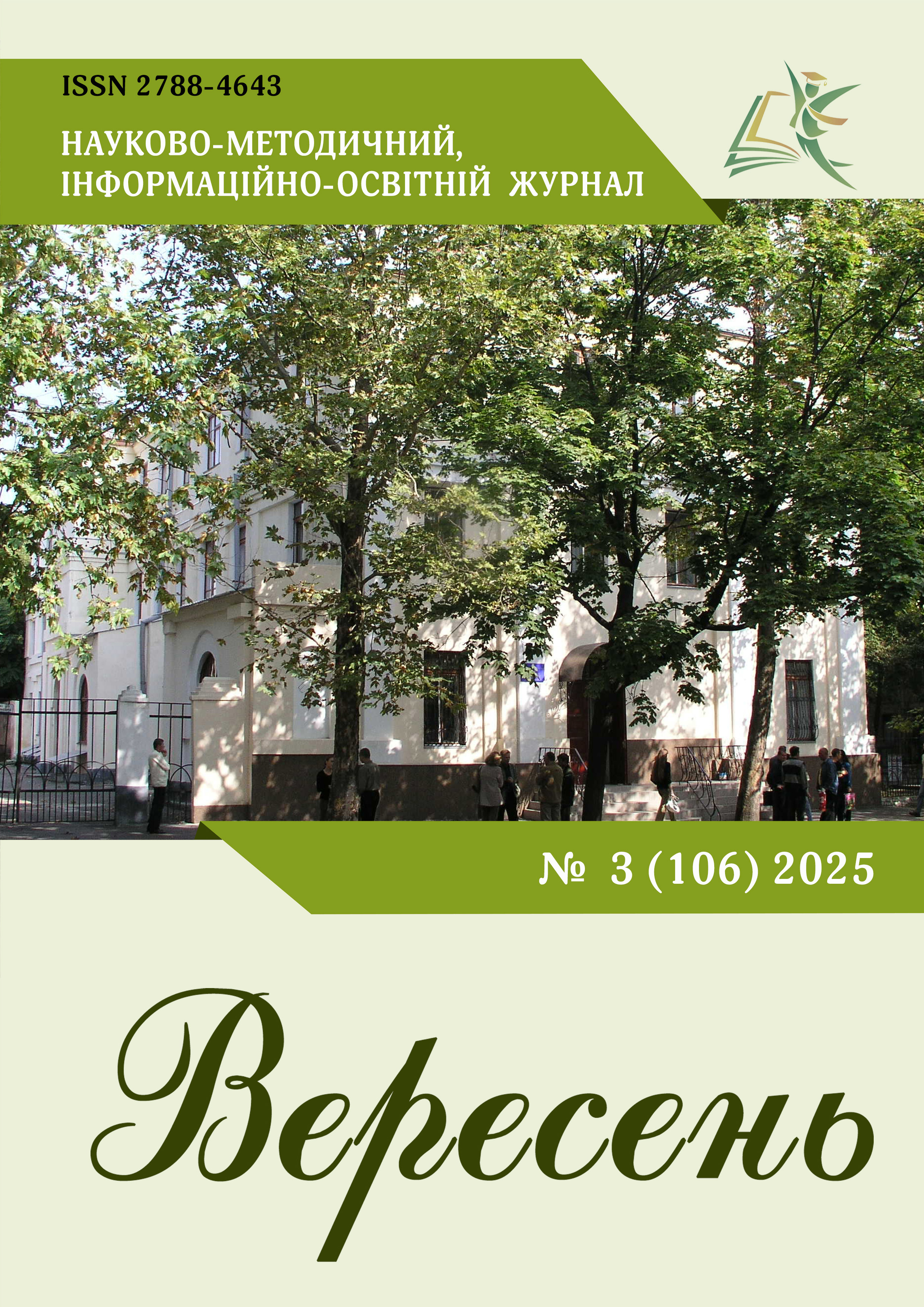СИНЕРГІЯ ПРОГРАМУВАННЯ ТА ПРИРОДНИЧО-МАТЕМАТИЧНИХ ДИСЦИПЛІН У КОНТЕКСТІ STEM-ОСВІТИ
DOI:
https://doi.org/10.54662/veresen.3.2025.04Ключові слова:
обчислювальне мислення, програмування, синергія, Python, STEMАнотація
У статті досліджено можливості синергії програмування та природничо-математичної освіти у школі. Показано роль мови Python як ефективного засобу міжпредметної інтеграції в контексті STEM-освіти. На основі аналізу наукових джерел і практичного досвіду авторів висвітлено потенціал Python для розвитку обчислювального мислення учнів, моделювання, аналізу даних та візуалізації природничих процесів. Окреслено виклики інтеграції програмування в шкільну освіту та запропоновано рішення. Набули розвитку методичні розв’язки інтеграції Python у STEM-предмети, зокрема в занятті «Кодимо розумно: алгоритмічні структури у Python. Структура повторення: цикл for», приклади завдань, інструментів і видів діяльності, що сприяють розвиткові обчислювального мислення учнів. Запропоновано низку практичних рішень: упровадження курсу для вчителів «Старт у світ кодування: Python для початківці», варіанти інтеграції програмування у STEM-дисципліни.
Посилання
Cheng, L., Wang, X., & Ritzhaupt, A. (2023). View all authors and affiliations. Journal of Educational Computing Research, 61 (2), 416–443. DOI: https://doi.org/10.1177/07356331221114183 (eng).
Grover, S., & Pea, R. (2013). Computational thinking in K–12: A review of the state of the field. Educational Researcher, 42(1), 38–43. DOI: https://doi.org/10.3102/0013189X12463051 (eng).
Hurt, T., Greenwald, E., & Allan, S. (2023). The computational thinking for science (CT-S) framework: Operationalizing CT-S for K–12 science education researchers and educators. Journal of Science Education and Technology, 10, 1–16. DOI: https://doi.org/10.1186/s40594-022-00391-7 (eng).
Kobylnyk, T. P., Kohut, U. P. & Zhydyk, V. B. (2021). Metodychni aspekty vyvchennia osnov alhorytmizatsii i prohramuvannia movoiu Python u shkilnomu kursi informatyky u starshykh klasakh [Methodical aspects of teaching the basics of algorithmization and programming in Python in high school informatics]. Fizyko-Matematychna Osvita, 5 (31), 36–44 (ukr).
Kobylnyk, T. P., Sikora, O. V., Zhydyk, V. B., & Sharan, O. V. (2022). Python yak zasib navchannia osnov alhorytmizatsii u zakladakh zahalnoi serednoi osvity [Python as a tool for teaching the basics of algorithmization in secondary schools]. Informatsiini Tekhnolohii i Zasoby Navchannia, 89 (3), 16–32. DOI: https://doi.org/10.33407/itlt.v89i3.4896 (ukr).
Lane, D., Galanti, T., & Rozas, H. L. (2023). Teacher re-novicing on the path to integrating computational thinking in high school physics instruction. Journal for STEM Education Research, 6, 302–325. DOI: https://doi.org/10.1007/s41979-023-00100-1 (eng).
Liskovych, O. V. (2023). Vykorystannia mozhlyvostei STEM-osvity u protsesi pidvyshchennia kvalifikatsii vchyteliv fizyky ta astranomii [Using STEM opportunities in teacher training]. Veresen, 2 (97), 40–49 (ukr).
Liu, Z., Gearty, Z., & Richard, E. (2024). Bringing computational thinking into classrooms: A systematic review on supporting teachers in integrating computational thinking into K–12 classrooms. International Journal of STEM Education, 11(1). DOI: https://doi.org/10.1186/s40594-024-00510-6 (eng).
Lohakan, M., & Seetao, C. (2024). Large-scale experiment in STEM education for high school students using artificial intelligence kit based on computer vision and Python. Heliyon, 10 (10). DOI: https://doi.org/10.1016/j.heliyon.2024.e31366 (eng).
Mahrovska, N. A., & Pohromska, H. S. (2025). Praktyko-tekhnolohichni aspekty vprovadzhennia alhorytmizatsii ta prohramuvannia v osvitnii protses [Practical and technological aspects of implementing algorithmization and programming in education]. Veresen, 1 (104), 13–24. DOI: https://doi.org/10.54662/veresen.1.2025.02 (ukr).
Meechai, L., & Choochat, S. (2024). Large-scale experiment in STEM education for high school students using artificial intelligence kit based on computer vision and Python. Heliyon, 10. Retrieved from: https://pmc.ncbi.nlm.nih.gov/articles/PMC11129092/ (eng).
MIT OpenCourseWare. (n.d.). Massachusetts Institute of Technology. Retrieved from: https://ocw.mit.edu/ (eng).
Next Generation Science Standards. (n.d.). NextGenScience. Retrieved from: https://www.nextgenscience.org (eng).
PISA 2022 results (Volume I): The state of education post-COVID-19. Retrieved from: https://www.oecd.org/en/publications/pisa-2022-results-volume-i_53f23881-en.html (eng).
Rakuta, V. M. (2024). Python u shkilnomu kursi informatyky. Osnovy prohramuvannia. [Python in school informatics course. Programming basics]. Chernihiv: [Self-published] (ukr).
Sabashyna, Y. (2023). Python u vosmomu klasi. Koly onovliat shkilnyi kurs informatyky ta yaki rezultaty pilotnoho proiektu [Python in 8th grade: When the school course will be updated]. Retrieved from: https://dou.ua/lenta/news/computer-science-in-schools/?utm_source=chatgpt.com (ukr).
Sengupta, P., Dickes, A., & Farris, A. V. (2021). Integrating computational thinking in K–12 science and math education. In Voicing code in STEM: A dialogical imagination (MIT Press). DOI: https://doi.org/10.7551/mitpress/11668.001.0001 (eng).
Tariq, R., Aponte Babines, B. M., Ramirez, J., Alvarez-Icaza, I., & Naseer, F. (2025). Computational thinking in STEM education: Current state-of-the-art and future research directions. Frontiers in Computer Science. Retrieved from: https://www.frontiersin.org/journals/computer-science/articles/10.3389/fcomp.2024.1480404/full (eng).
Weintrop, D., Beheshti, E., & Horn, M. (2016). Defining computational thinking for mathematics and science classrooms. Journal of Science Education and Technology, 25, 127–147. DOI: https://doi.org/10.1007/s10956-015-9581-5 (eng).
Wing, J. M. (2006). Computational thinking. Communications of the ACM, 49 (3), 33–35. DOI: https://doi.org/10.1145/1118178.1118215 (eng).
Yang, D., Baek, Y., Ching, Y., Swanson, S., Chittoori, B., & Wang, S. (2021). Infusing computational thinking in an integrated STEM curriculum: User reactions and lessons learned. European Journal of STEM Education, 6 (1). DOI: https://doi.org/10.20897/ejsteme/9559 (eng).
Ye, H., Liang, B., & Ng, O. L. (2023). Integration of computational thinking in K–12 mathematics education: A systematic review on CT-based mathematics instruction and student learning. International Journal of STEM Education, 10 (3). DOI: https://doi.org/10.1186/s40594-023-00396-w (eng).




